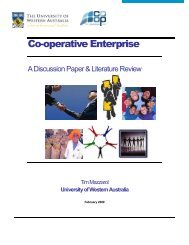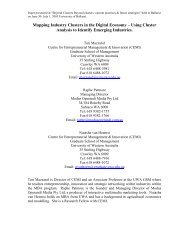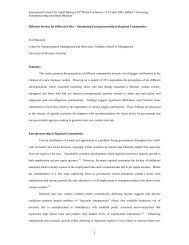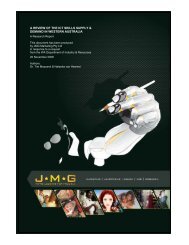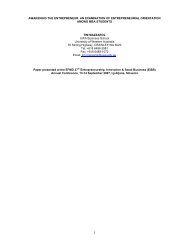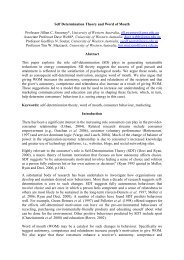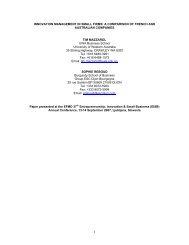The Third Wave: Future Trends in International Education - CEMI
The Third Wave: Future Trends in International Education - CEMI
The Third Wave: Future Trends in International Education - CEMI
You also want an ePaper? Increase the reach of your titles
YUMPU automatically turns print PDFs into web optimized ePapers that Google loves.
Centre for Entrepreneurial Management and Innovation<br />
<strong>The</strong> <strong>Third</strong> <strong>Wave</strong>: <strong>Future</strong> <strong>Trends</strong> <strong>in</strong> <strong>International</strong> <strong>Education</strong><br />
5<br />
Larger organisations, with significant ownership advantages, have favoured sole or jo<strong>in</strong>t venture entry modes.<br />
Smaller organisations, that usually lack resources, have preferred direct export<strong>in</strong>g or jo<strong>in</strong>t venture entry<br />
modes, usually driven by a desire to reduce costs and risk. When there are high contractual risks, organisations<br />
with well-differentiated products are likely to prefer <strong>in</strong>vestment to export<strong>in</strong>g. However, when <strong>in</strong>vestment risk<br />
is high, export modes are preferred (Agarwal and Ramaswami 1992). <strong>The</strong> foreign market entry strategy<br />
decision requires an evaluation of four critical variables (risk, return, cost, and control) (Rugman and Verbeke<br />
1992; Hill and Kim 1988; Goodnow 1985; Anderson and Coughlan 1987). This evaluation has been termed<br />
transaction cost analysis and it suggests that a firm will <strong>in</strong>ternalise activities it can perform at lower cost and<br />
will outsource activities when other providers have an advantage (Anderson and Weitz 1986).<br />
THE INTERNATIONALISATION OF EDUCATION SERVICES<br />
Erramilli (1990) suggested that there were ‘hard’ and ‘soft’ services and that this dist<strong>in</strong>ction was important <strong>in</strong><br />
the development of market<strong>in</strong>g operations. Hard service providers can separate the production and<br />
consumption of their service (e.g. architecture), while soft service providers cannot (e.g. education). ‘Hard’<br />
services can be exported directly but ‘soft’ services need some form of forward <strong>in</strong>tegration if an enterprise is<br />
to establish an <strong>in</strong>ternational presence. Erramilli and Rao (1990; 1990) suggested services exporters can be<br />
divided <strong>in</strong>to ‘client follow<strong>in</strong>g’ and ‘market seek<strong>in</strong>g’ firms. <strong>The</strong> first group exported because clients moved<br />
<strong>in</strong>ternationally and they were obliged to follow. <strong>The</strong> second group actively sought foreign market<br />
opportunities. On this basis, education can be classified as a ‘soft’ service and most <strong>in</strong>stitutions engaged <strong>in</strong><br />
<strong>in</strong>ternational markets are ‘market seek<strong>in</strong>g’ organisations.<br />
Cowell (1984) identified six foreign market entry strategies for service enterprises (direct export, licens<strong>in</strong>g,<br />
franchis<strong>in</strong>g, jo<strong>in</strong>t ventures, acquisition and management contract<strong>in</strong>g). Direct export can <strong>in</strong>volve a service<br />
enterprise send<strong>in</strong>g representatives abroad. However, <strong>in</strong> the case of education direct export has been a ‘first<br />
wave’ approach, with students travell<strong>in</strong>g from source to host countries. Licens<strong>in</strong>g, franchis<strong>in</strong>g, jo<strong>in</strong>t ventures<br />
and management contract<strong>in</strong>g strategies require an <strong>in</strong>stitution to move offshore or forward <strong>in</strong>to its export<br />
channels, usually with an <strong>in</strong>ternational alliance partner or as a coalition member. This is also often the case for<br />
acquisition strategies that, by foreign government regulation, usually require local coalition partners. “Forward<br />
<strong>in</strong>tegration” (mov<strong>in</strong>g offshore <strong>in</strong>to an export channel) is a logical second stage (after direct export) <strong>in</strong> the<br />
<strong>in</strong>ternationalisation of education service providers. It can also offer considerable competitive advantage to<br />
<strong>in</strong>stitutions that embrace such strategies (Soutar and Mazzarol 1995).<br />
In <strong>in</strong>ternational markets, ‘spatial pre-emption’ can be obta<strong>in</strong>ed through an appropriate foreign market entry<br />
strategy and, <strong>in</strong> turn, through the channel structure adopted. Because production and consumption are<br />
difficult to separate <strong>in</strong> services, the location of service delivery outlets is of critical importance (Allen 1988). For<br />
this reason, the ‘pre-emption’ of strategic locations can be a source of competitive advantage with<strong>in</strong> a service<br />
<strong>in</strong>dustry (Bharadwaj, Varadarajan and Fahy 1993).<br />
Accord<strong>in</strong>g to Terpstra (1987: 333) market entry is “one of the most critical decisions <strong>in</strong> <strong>in</strong>ternational<br />
market<strong>in</strong>g” as it sets the framework for channel structure and the level of control a firm will have over its<br />
market<strong>in</strong>g channel (Stern and El-Ansary 1982). Anderson and Coughlan (1987) noted that an <strong>in</strong>tegrated (i.e.<br />
jo<strong>in</strong>t venture) or an <strong>in</strong>dependent channel structure may be suitable. Determ<strong>in</strong><strong>in</strong>g which approach to take is a<br />
complex task, <strong>in</strong>fluenced by such factors as the level of <strong>in</strong>tangibility with<strong>in</strong> the service component and the age<br />
of the product category.<br />
<strong>The</strong> <strong>in</strong>separability of service production and consumption <strong>in</strong>creases the need for service exporters to <strong>in</strong>tegrate<br />
forward <strong>in</strong>to their market<strong>in</strong>g channel and establish ‘foreign manufactur<strong>in</strong>g facilities’ (Nicouland 1989).<br />
Because ‘soft’ services, such as education, <strong>in</strong>volve a high degree of ‘consumer and producer <strong>in</strong>teraction’<br />
Centre for Entrepreneurial Management and Innovation | www.cemi.com.au



